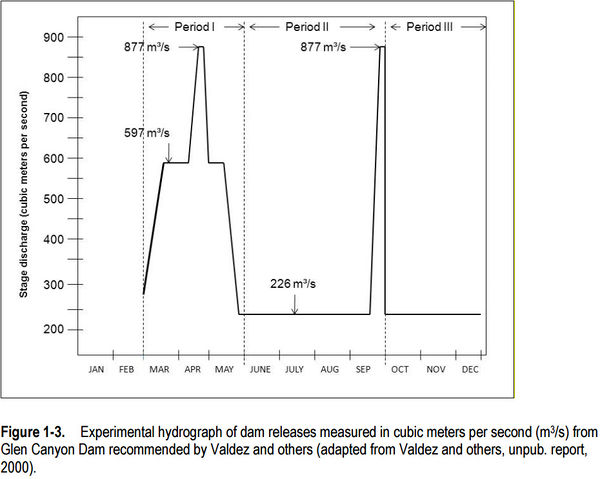Difference between revisions of "Low Summer Flow Experiment"
Cellsworth (Talk | contribs) |
Cellsworth (Talk | contribs) |
||
| Line 62: | Line 62: | ||
|style="color:#000;"| | |style="color:#000;"| | ||
| − | Increase humpback chub growth | + | Increase [http://gcdamp.com/index.php?title=TEMPERATURE mainstem river temperature] to increase [http://gcdamp.com/index.php?title=Humpback_Chub_Page humpback chub growth.] |
|- | |- | ||
| Line 92: | Line 92: | ||
|style="color:#000;"| | |style="color:#000;"| | ||
| − | *Reduced food availability to humpback chub by | + | *Reduced [http://gcdamp.com/index.php?title=FOOD_BASE food availability] to humpback chub by |
# desiccating the nearshore environment with the reduction in flow between June and July, and | # desiccating the nearshore environment with the reduction in flow between June and July, and | ||
# reducing drift with the reduction in daily fluctuation. | # reducing drift with the reduction in daily fluctuation. | ||
| − | *Increased bioenergetic demands of humpback chub via warmer water while decreasing food supply and availability. | + | *Increased [http://gcdamp.com/index.php?title=Bioenergetics_Studies bioenergetic demands] of humpback chub via warmer water while decreasing food supply and availability. |
| − | *Increased sediment transport during the high releases in the months prior to the LFS test in order to get the annual volume commitment to the Lower Basin. | + | *Increased [http://gcdamp.com/index.php?title=GCDAMP_Sediment sediment transport] during the high releases in the months prior to the LFS test in order to get the annual volume commitment to the Lower Basin. |
| − | *Increased potential for nonnative fish and parasites to proliferate throughout the Grand Canyon and impact humpback chub and other native fish populations. | + | *Increased potential for [http://gcdamp.com/index.php?title=Nonnative_Invasive_Aquatic_Species nonnative fish and parasites] to proliferate throughout the Grand Canyon and impact humpback chub and other native fish populations. |
*The cost to hydropower users from [http://gcdamp.com/index.php?title=The_2000_Low_Summer_Steady_Flow_Experiment '''the 2000 Low Summer Steady Flow Experiment'''] was estimated to be $26.4 M, which probably made it the single most expensive science experiment in US history. | *The cost to hydropower users from [http://gcdamp.com/index.php?title=The_2000_Low_Summer_Steady_Flow_Experiment '''the 2000 Low Summer Steady Flow Experiment'''] was estimated to be $26.4 M, which probably made it the single most expensive science experiment in US history. | ||
Revision as of 15:46, 3 May 2017
|
|
LTEMP Experimental Action: Aquatic Resource-Related Experimental Treatments (BA, pages 30-41) [1]Low summer flows may be tested in the second 10 years of the LTEMP period, for the purpose of achieving warmer river temperatures (≥14°C) to benefit humpback chub and other native species. Under low summer flows, daily fluctuations would be less than under base operations (e.g., approximately 2,000 cfs). Investigating the anticipated effects of and options for providing warmer water temperatures in the mainstem Colorado River through Grand Canyon is an identified management action in the Humpback Chub Recovery Goals (USFWS 2002a). |
| --- |
--- |
--- |
|---|
|
|
